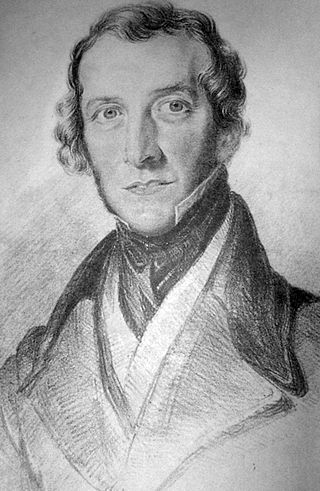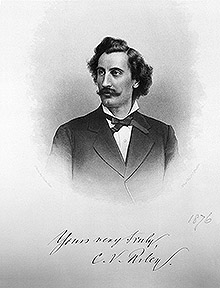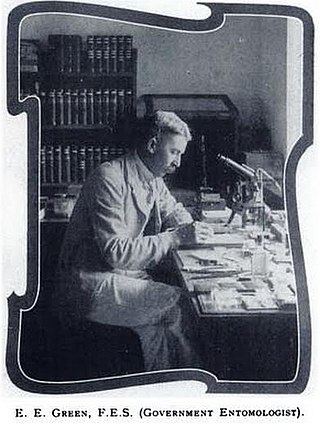
John Obadiah Westwood was an English entomologist and archaeologist also noted for his artistic talents. He published several illustrated works on insects and antiquities. He was among the first entomologists with an academic position at Oxford University. He was a natural theologian, staunchly anti-Darwinian, and sometimes adopted a quinarian viewpoint. Although he never travelled widely, he described species from around the world on the basis of specimens, especially of the larger, curious, and colourful species, obtained by naturalists and collectors in England.

Dru Drury was a British collector of natural history specimens and an entomologist. He received specimens collected from across the world through a network of ship's officers and collectors including Henry Smeathman. His collections were utilized by many entomologists of his time to describe and name new species and he is best known for his book Illustrations of natural history which includes the names and descriptions of many insects, published in parts from 1770 to 1782 with most of the copperplate engravings done by Moses Harris.

George Robert Waterhouse was an English naturalist. He was a keeper at the department of geology and later curator of the Zoological Society of London's museum.

Francis Walker was an English entomologist. He was born in Southgate, London, on 31 July 1809 and died at Wanstead, England on 5 October 1874. He was one of the most prolific authors in entomology, and stirred controversy during his later life as his publications resulted in a huge number of junior synonyms. However, his assiduous work on the collections of the British Museum had great significance.

James Charles Dale was an English naturalist who devoted almost all of his adult life to entomology.

The Royal Entomological Society is devoted to the study of insects. Its aims are to disseminate information about insects and improving communication between entomologists.

Frederick William Hope was an English clergyman, naturalist, collector, and entomologist, who founded a professorship at the University of Oxford to which he gave his entire collections of insects in 1849. He described numerous species and was a founder of the Entomological Society of London in 1833 along with John Obadiah Westwood.

Charles Valentine Riley was a British-born American entomologist and artist. He was one of the first individuals to use biological pest control and authored over 2,400 publications. He convinced Congress to create the United States Entomological Commission and was among the founders of the American Association of Economic Entomologists.

David Sharp was an English physician and entomologist who worked mainly on Coleoptera. He was among the most prolific publishers in the history of entomology with more than 250 papers that included seven major revisions and reviews and a highly influential work on the structure and modifications of the male genital structures among the beetle families. He was the editor of the Zoological Record for three decades.

Adam White was a Scottish zoologist.
Herbert Edward Andrewes was a stockbroker and an English entomologist who specialised in beetles of the order Coleoptera.

Walther Hermann Richard Horn was a German physician and entomologist who specialised in beetles (Coleoptera), particularly the tiger beetles. He became the founding director of the German entomological institute where he collaborated with entomologists around the world. He is not to be confused with the American entomologist George Henry Horn who also studied Coleoptera.

Edward Ernest Green was an Ceylon-born English mycologist and entomologist who specialised in the scale-insects, Coccidae. An accomplished artist, and lithographer, he illustrated the five volume Coccidae of Ceylon.
John Hartley Durrant was an English entomologist who specialised in Lepidoptera.
Oliver Erichson Janson was an English entomologist who specialised in Coleoptera.
Frederic John Sidney Parry was an English entomologist who specialised in Coleoptera, principally Lucanidae.

Thomas Blackburn was an English-born Australian priest and entomologist who specialized in the study of beetles.
John Walton was an English entomologist who specialised in Coleoptera especially Curculionidae. His collection is held by the Natural History Museum, London John Walton was educated in first in Knaresborough then in London where he studied Chemistry at the Mathematical Society of Spitalfields, then applying his science to sugar refining in his uncles refinery based in Whitechapel whom he succeeded in that lucrative business. By then wealthy he retired in 1832 to devote himself to entomology. He corresponded with Carl Johan Schönherr, Ernst Friedrich Germar and Louis Alexandre Auguste Chevrolat exchanging specimens with all three.
Beulah Garner FRES is an entomologist in the United Kingdom. She is Senior Curator at the Natural History Museum, London and is an expert of beetles, in particular the ground beetles (Carabidae).
Edward Mason Janson was a British entomologist who lived and worked in Nicaragua.














